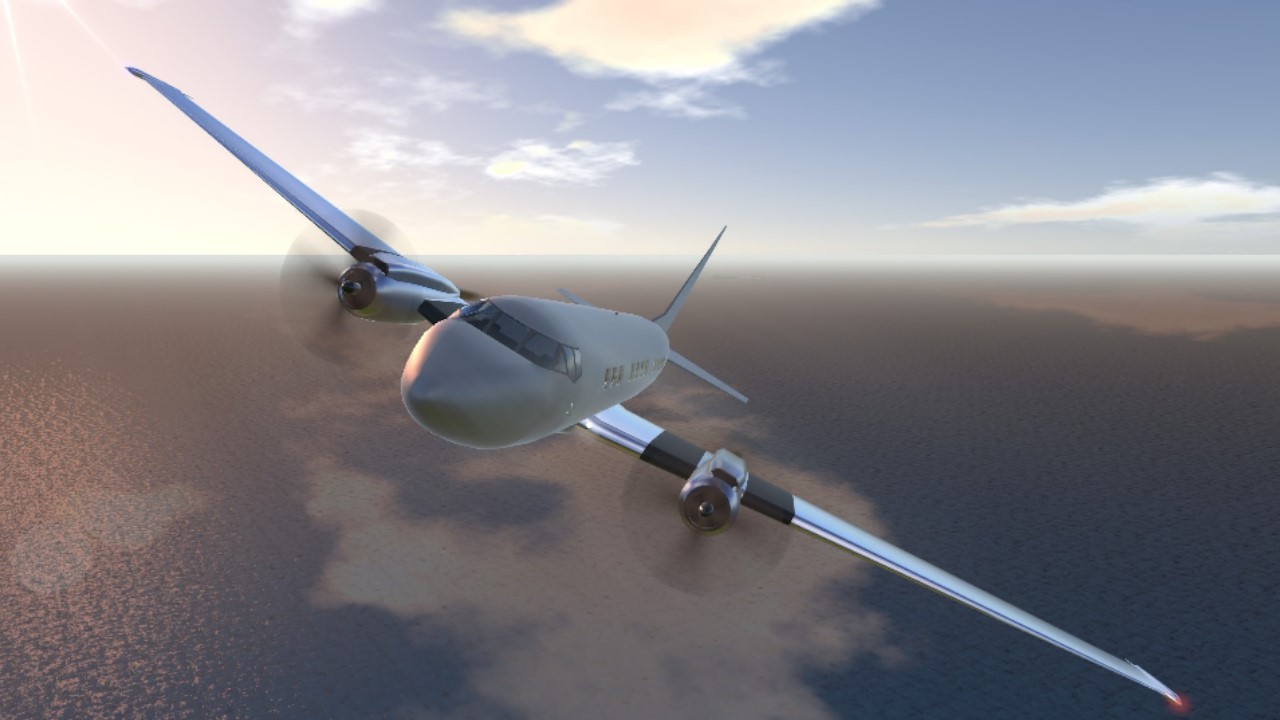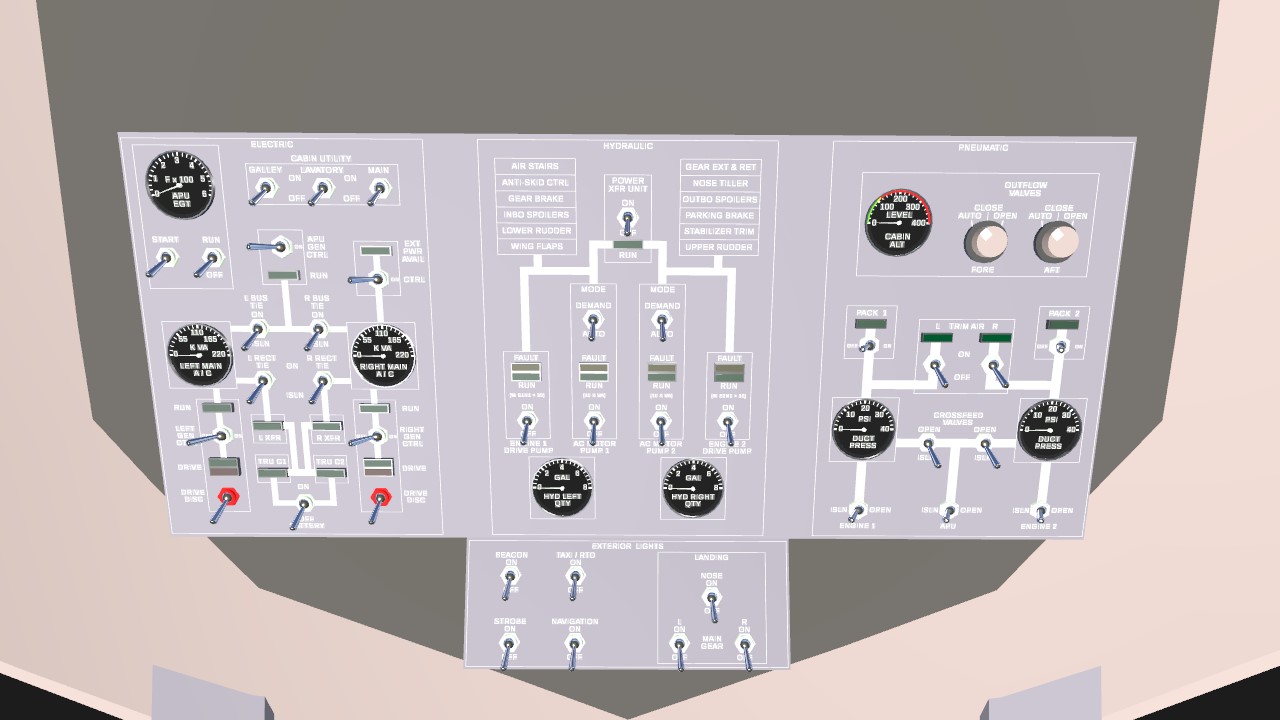Welcome to the RA40 Excelsior, a short-haul passenger transport ideal for servicing even the smallest airfield in SimplePlanes. An older design originating from the early 1960s, this turboprop has a mostly analog cockpit setup.
This craft demonstrates a more realistic understanding of the primary systems abord an airliner: hydraulics, fuel/transfer, electrics and pneumatics. Featuring a fully functional cockpit, she delivers an immersive experience with a VR cockpit and operational checklists. She boasts a rudimentary landing assist for Wright Airport runway 36, using a coordination of distance, speed, descent rate and runway centerline tracking.
AG 7 for airstairs

ELECTRICS - The electric system is derivative of a B727 and B737. Its AC system is powered via three 120 K VA generators (one per engine and one for the APU) into a left and right AC, and an exterior 220 connection. The AC will then energize a respective DC system. To note, without DC and the battery, most cockpit instruments are useless.
FUEL - A significant leap from my previous build, fuel crossfeed is available between the two fuel tanks (only two tanks for this craft).
HYDRAULICS - Based off a Dehavilland Dash 8, the hydraulics are still quite rudimentary (see final paragraph for explanation as to why this feature was omitted). The hydraulics actuate, among other things, the rudders, landing gear and flaps. With a left and right system, she has a one-way power transfer unit (right to left) in case of loss of right AC and the number two engine.
PNEUMATICS - Based off a B737, it's a rather simple setup with not too much going on. Really, the only aspect of the pneumatics that can be enjoyed in VR are cabin pressure and the engine starters (and anti-ice for optics)



LANDING ASSIST - This is accomplished using distance, speed, descent rate, and a basic centerline guide for Wright Airport runway 36. By inputting the runway altitude into the digital display and selecting "APPLY," that altitude entered will become "0" (ground level) on the rotary altitude gauge.
Calculating landing distances is a bit more complicated. I recently taught myself how to do this and have conducted a many successful approaches of varying precision (practice makes perfect) using the 1 in 60 rule. The below link is how I got a basic understanding of this stuff.
https://www.boldmethod.com/learn-to-fly/navigation/how-the-60-to-1-rule-helps-you-plan-a-perfect-descent/
Omissions from original concept plans: Most notably, the variables menu seems to glitch after so many lines of code, which stopped me short of programming the hydraulic pressure use-reduction. An autopilot system is, for the time being, beyond my abilities in terms of developing the necessary matrices to pull that off. Cockpit lighting was also ruled out very early when designing this, as switches (as distinct from buttons) misbehave with part movement. Additionally, to save on part count, I elected not to include a master caution indicator system.
Find yourself a good chunk of time, slap on your VR headset and dive on in. Comments, feedback and funky tree questions are welcome and encouraged.
Happy flying friends
Specifications
Spotlights
- Erc90F4RU 1.5 years ago
- TheCommentaryGuy 1.5 years ago
- YarisSedan 10 months ago
- TheOfficalMarylander 1.5 years ago
- ChihiroFujisaki 1.5 years ago
- TheMouse 1.5 years ago
- MIGFOXHOUND31BSM26 1.5 years ago
General Characteristics
- Successors 1 airplane(s) +7 bonus
- Created On Windows
- Wingspan 93.7ft (28.5m)
- Length 69.1ft (21.1m)
- Height 25.9ft (7.9m)
- Empty Weight 34,522lbs (15,658kg)
- Loaded Weight 69,142lbs (31,362kg)
Performance
- Power/Weight Ratio 0.651
- Horse Power/Weight Ratio 0.028
- Wing Loading 41.1lbs/ft2 (200.8kg/m2)
- Wing Area 1,680.9ft2 (156.2m2)
- Drag Points 14023
Parts
- Number of Parts 1049
- Control Surfaces 9
- Performance Cost 7,049







@fleia262 You did an awesome job and im sure you will on any upcoming aircraft! an i just found the passenger aircraft. Absolute masterpiece keep up the good work ill be following any aircraft you put out!
@justrandom Thank you!! So happy you enjoy it! I'm glad I was able to find my niche, haha. I have a couple of single-pilot light aircraft on the way while starting on my next project. Far fewer parts so hopefully the VR quality can be set to max and still be comfortable.
This plane is severly underrated i love the start up and cockpit especially in VR goodwork man.
@MrCOPTY it's based off a non-fiction aircraft so I truly hope she's not overly alien lol (not that i dont want her to stand out). My goal is for her to feel like a Bombarier or an older Boeing (B-337 or a dc-6 style).
some parts looks familiar
@fleia262 With me, coding in the variables window is impossible due to the complexity of my code (in fact, 1000 variables is after I simplified and improved the code from 2000!). Some variables contain giant paragraphs of code, which is beyond impossible to deal with in the window. In fact, I don't just use one notepad window; I used over four monitors of code and diagrams when I was developing the FMC.
@PlaneFlightX One of the biggest lessons I took away from this flight deck was that my method of creating the variables was needlessly inefficient. I've been able to do a lot more with a lot less in my latest project, to my surprise. And thank you! I'll definitely have to consider your recommendation of the notepad++. As I'm sure you've experienced, sifting from side to side thru a massive line of code from a tiny window is mind-numbing, haha.
I read the last paragraph about variables, and there is a solution: use a text editor.
My plane has over 1000 variables, some being absurdly complex, and I just do all the coding in notepad++.
@fleia262 Thanks for the recent updates on my post! I can't help but notice you are amazing at building planes! But why all fictional? It would be really cool to build a real plane with that level of skill.
@fleia262 thanks so much
@Kinoftheworldanv start by pushing pretty much all the buttons on the overhead console except for the Drive Disconnect switches. Sor the APU syart, hole the starter for about 5 seconds til the gauge increases. Sane for the Fuel conteol panel on the dash by the engins instruments. Then on the center control console, switch on the igniter sitches and the knobs for the starter valves. Then the yellow handled levers should be pushed fully forward. The engines will then start. Mostly you'll want to refer to the checklist on the black rectangle on the yoke, using the arrows. Hope this answers the question and enjoy!
I am so confused on finding way to start up plane, can u help?
@fleia262 Yes indeed it is, my bro. ;) =D
Hi!
@Erc90F4RU
@Boeing777x
Welcome old friends, always great to hear from yall!
long time no see
hello
@TheMouse
@BYardley
@Solent19
It's always good to see a new plane from an old friend of mine. ;)
Great plane